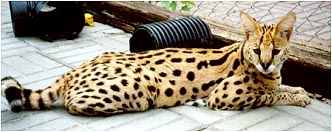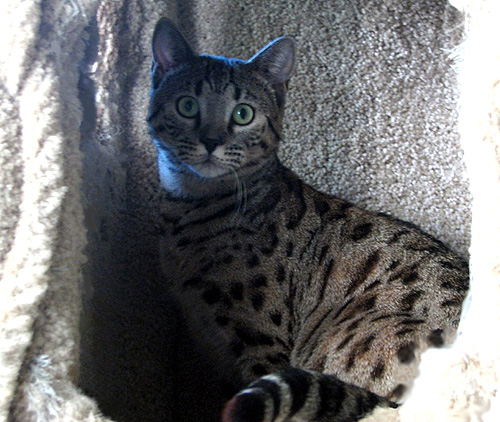
A stunning F3 Savannah Cat "Foothill Felines Safari Spots"
Her great-grandfather is an African Serval.
Photo by Tammie Ekkelboom.

A stunning F3 Savannah Cat "Foothill Felines Safari Spots"
Her great-grandfather is an African Serval.
Photo by Tammie Ekkelboom.
The Savannah cat is one of the newest and most exciting breeds of cats currently being developed by a select few breeders around the world. There are still relatively few Savannahs in existence, and the demand for them is quite high. The Savannah is the result of crossing an African Serval cat to a domestic cat. Since with any hybrid cross resulting from the breeding of a wild cat to a domestic cat, the males are almost always sterile until the 4th-5th generation, there are a variety of domestic intact male cats used in breeding programs to create the early generation Savannahs. Some toms that are being used in the early generations include Oriental Shorthairs, Egyptian Maus, Serengetis, Bengals, and others.
While it is natural and not difficult to have a Serval breed with another Serval, it can be extremely difficult to accomplish the Serval to domestic cat breeding. Whether it be the Serval male to the domestic female (which is most often the case), or to attempt a female Serval to a domestic male ... because the Serval body type is so much longer and taller, this makes the pairing physically quite challenging. Add to that the differences in behavior between a wild cat and a domestic cat, and in some cases, too much aggression on the part of an intact adult Serval ... these are all important reasons why the creation of an exciting new breed of cat like this is really just like "giving birth" for the breeders with their hearts, souls and pocketbooks firmly invested in these cats that they love. In the wild, Serval mothers carry their kittens in utero a full 10 days longer than their domestic queen counterparts. Thus, every healthy, full-term F1 Savannah kitten that is born is truly a small miracle all in itself.
The first documented breeding of an African Serval to a domestic cat was accomplished in the mid 1980's by Judy Frank, a Bengal breeder and cat fancier in Pennsylvania. The Savannah breed, still in the early stages of development, provides a smaller, more manageable version of the beautiful, exotic Serval Cat for people to live with and enjoy appropriately in our own homes. Savannahs are generally quite content as indoor-only housecats, and usually make wonderful family pets. While the Serval can be anywhere from 30-50 pounds, and stand quite tall on those long legs, Savannahs are typically most often reaching an adult weight of between 18-25 pounds. Unlike Servals, Savannahs use litterboxes and do not require any special diets, facilities or veterinary care than any other type of domestic housecat.

KEYSTONE of Select Exotics - an African Serval
He is the Serval ancestor of the cats in our Savannah breeding program here at Foothill Felines.
Photo courtesy of Keystone's owners, Dale and Holly Hummel, SelectExotics cattery, in Illinois.
The kittens resulting from the first and subsequent generations from the breeding of a Serval cat to a domestic cat or a Serval cat to a Savannah cat are recognized as DOMESTIC Savannah cats. The goal of the Savannah breeding program is to create a uniquely beautiful domestic cat which retains many of the beautiful physical features distinctive to the Serval cat, yet incorporating the loving, dependable temperament of the typical domestic cat. Savannahs are known to be extremely friendly and talkative; very playful and curious in nature. They are the largest hybrid cat available at this time.
This breed was named for the native African grasslands where the Serval makes its home, and also for the first and only Savannah kitten produced by Ms. Frank, who named the female kitten resulting from this Serval/domestic shorthair cross "Savannah". Savannahs are breathtakingly gorgeous, with beautiful spotted and striped coats and colors ranging from silver to amber. They have distinctive "tear drop" markings around their eyes and large round ears. The Savannah is a very graceful, uniquely built cat, with a lovely long neck, long legs and ears, and a three-quarter length tail. The breed standard states that they may be solid, tabby or silver/shaded in pattern, with the allowable colors in those patterns to be black, brown spotted tabby, silver spotted tabby or black smoke. The breed standard calls for a head shape that is longer than it is wide. When the face is viewed from the front it should form a distinct triangle. The head of the Savannah is slightly smaller than in proportion to the body. In profile, the nose is long but with a small chin and should add to the cat's wild appearance. The ears of the Savannah are to be large and alert, with a wide base and slightly rounded tips.
| PLEASE NOTE: We've researched the history of the Savannah breed to the very best of our ability. Please let us know if we've made any errors or omissions here, as that was certainly not our intention. We are extremely grateful to all the breeders whose hard work, perseverence and dedication have played such a vital role in the development of this amazing new cat breed. |
The first generation cross is referred to as the F1 (Serval x domestic). The next breeding of (F1 Savannah x domestic) will create a litter of F2 generation Savannah kittens. Because of the fact that the first three generations (F1, F2 and F3 - and sometimes even the 4th generation) of Savannah males are sterile and cannot reproduce, it will usually be 5 generations or more before there can be a Savannah to Savannah breeding. In 1996, Savannah breeders first presented their breed to the TICA board of directors, at which time they gained registration rights. The Savannah has continued to evolve both in its development as a breed, and in the recognition and popularity of the breed through The International Cat Association (TICA) and in the hearts of cat fanciers around the world.
In 2001, TICA granted evaluation status to this exciting new breed, which means that you may see Savannahs of F3 or beyond generation, being shown in the evaluation rings at TICA shows throughout the world where they are being bred and shown. Below, you can follow the pictures and cats to
see the development of one of our current Savannah breeding lines here at Foothill Felines, from the original African Serval, through the next 5 generations of Savannah offspring.

SERVAL

F1

F2

F3

F4

F5

F5
![]() CLICK HERE for the most up-to-date Savannah Breed Standard, per TICA.
CLICK HERE for the most up-to-date Savannah Breed Standard, per TICA.
![]() CLICK HERE to see our photo gallery of AFRICAN SERVAL CATS.
CLICK HERE to see our photo gallery of AFRICAN SERVAL CATS.
|
 | © 1996-2008 Copyright
by HDW Enterprises, Inc. - All Rights Reserved. 
HDW Enterprises, Inc., P.O. Box 418104, Sacramento, CA 95841-8104 (916) 481-CATS ph/fax http://www.hdw-inc.com e-mail: holly@hdw-inc.com |